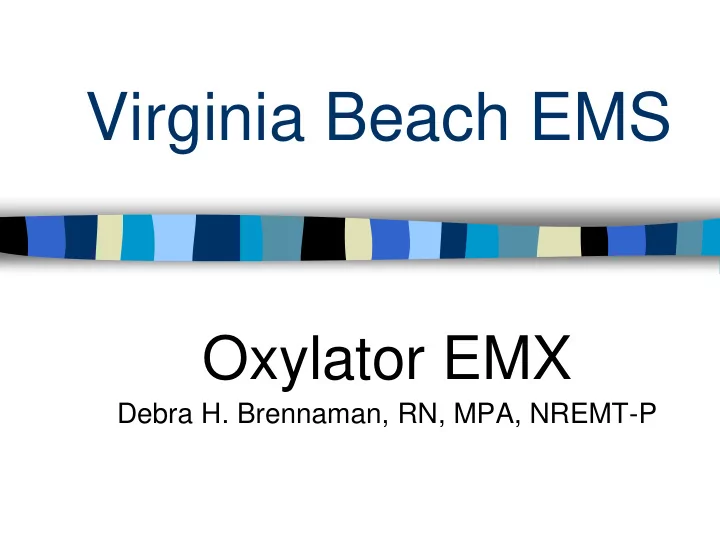

Virginia Beach EMS Oxylator EMX Debra H. Brennaman, RN, MPA, NREMT-P
Oxylator EMX Overview Patient responsive oxygen powered resuscitation / ventilation device intended to provide emergency ventilatory support for apneic patients.
Oxylator EMX Oxygen-powered – No batteries – Uses compressed oxygen – Can use compressed air (SCBA adapter)
Oxylator EMX Not a demand valve or vent Patient responsive Adapts to patient’s inspiratory:expiratory ratio to deliver “normal” breaths
Oxylator EMX Flow rate < 30 LPM Pressure 20-45 cm H 2 0 100% oxygen to patient Delivers 500 cc/second Inspiratory goal – Adult: 1 – 1 ½ second • 500-750 cc – Child (must be >10 kg): 1 second • 500 cc
Oxylator EMX Uses Anytime BVM used – BLS with Cuffed Mask – Cuffed ETT – Combitube – Cricothyrotomy (Melkor)
Pilot Implementation Approved for use by Paramedics and Intermediates who have completed the required training Initial deployment – Zone cars – MCI truck
Pilot Implementation Patient limitations > 8 years old > 55 lbs Won’t “cycle” with uncuffed ETT 16 + age 4
Oxylator EMX Operation Automatic Manual without PEEP Manual with PEEP Spontaneous respirations
Oxylator EMX Parts
Oxylator EMX Parts Gold O 2 button - oxygen release button Press for manual Turn ¼ turn clockwise to lock for automatic
Oxylator EMX Parts Maximum airway pressure setting Indicator eye 20-45 cm H 2 0 Acts as “pop - off” setting When airway pressure reaches set level, inspiration stops
Oxylator EMX Parts INH inhalator knob Open to allow free-flow oxygen When open in manual mode creates PEEP
Oxylator EMX Parts Top Cap Black piston moves as Oxylator “cycles” Piston in = inspiratory phase Piston out = expiratory phase
Oxylator EMX Parts Filter – internal Single patient use Prevents contaminants from entering Oxylator EMX
Oxylator EMX Parts Filter - external – 1644 Clear Guard Midi 99.9% Efficient – HME Humidifying Single patient use Prevents contaminants from entering Oxylator EMX
Oxylator EMX Parts Extension Tubing Prevents weight of Oxylator from dislodging ETT
Oxylator EMX Parts Oxygen connection Does not require wrenches!
You got all that?
Oxylator EMX Operation Automatic Manual without PEEP Manual with PEEP Spontaneous respirations
Automatic Use Inspiratory “trigger pressure” 5 cmH 2 0 As patient exhales, when pressure in airway falls below 5 cmH 2 0, it triggers inspiratory cycle Avoids “stacking breaths” because will not start inspiration until exhalation complete Delivers 2-4 cmH 2 0 PEEP
BLS Automatic Use Use cuffed mask Position patient’s head – Use oral or nasal airway Good mask seal
BLS Automatic Use Start at 20 cmH 2 0 Turn gold O 2 knob ¼ turn clockwise to lock Once Oxylator EMX “cycles” adjust pressure setting upward until correct inspiration time achieved 1 to 1 ½ seconds for adult 1 second for child
BLS Automatic Use Confirm ventilation – Chest rise and fall – Color improvement – Breath sounds Always reset to 20 cmH 2 0 after use
ALS Automatic Use Intubate patient with cuffed ETT Verify placement – Visualize cords – Breath sounds – End-tidal CO2 Use extension tubing to prevent dislodged ETT If extension tubing is unavailable, ensure ETT well secured
ALS Automatic Use Set pressure to 35 cmH 2 0 – Higher maximum airway resistance required since ETT narrows airway Turn gold O 2 knob ¼ turn clockwise to lock Once Oxylator EMX “cycles” adjust pressure setting upward until correct inspiration time achieved 1 to 1 ½ seconds for adult 1 second for child
ALS Automatic Use Confirm ventilation – Breath Sounds – End tidal CO 2 – Chest rise and fall – Color improvement Always reset to 20 cmH 2 0 after use
What about AHA Guidelines 2005 concerning hyperventilation?? AHA Guidelines for BVM BVM dependent on number of breaths per minute administered by provider Increase ventilation rate does not allow for complete expiration Results in stacking of breaths = increased intrathoracic pressure
Manual Use If inspiratory time is too long in automatic mode: > 2 second for adults > 1 second for child must switch to manual mode To assist ventilations – Irregular airway patterns – CHF with inadequate ventilations • CPAP contraindicated with inadequate ventilations
Manual Use Press gold O 2 oxygen release button 1 – 1 ½ seconds for adults 1 second for child INH knob open Baseline PEEP 2-4 cmH 2 0 INH knob closed Baseline PEEP 0
Oxylator EMX with CPR Unprotected airway Use manual mode 30 compressions: 2 breaths Intubated patient Continuous compressions Automatic mode Start pressure at 20-25 cmH 2 0 Increase pressure if needed to avoid device stuttering
Patient with Spontaneous Ventilations Open INH knob Allows free flow of oxygen at approximately 15 LPM
Trouble shooting Fails to cycle ETT cuff leak? ETT too small? Not enough oxygen in tank? Esophageal intubation???
Oxygen Duration Cylinder Capacity Oxygen duration D portable 420 liters 28 minutes Super D portable 650 liters 43 minutes M main 4,950 liters 5.5 hours
Troubleshooting “Stuttering” sound Turn oxygen release button off Check for airway obstruction or kinked tube If no obstruction, increase pressure by 5cmH 2 0 and reapply in automatic mode. Repeat until stuttering ceases. Use manual mode if necessary
Troubleshooting When lung volume decreases, cycles speed up Cycles speed up suddenly Tension pneumo? Right mainstem intubation?
Troubleshooting Cycles speed up slowly Lung compliance falling? Pulmonary edema worsening?
Asthma As bronchoconstriction worsens, pressure in airways increases Oxylator will cycle faster Results in hyperventilation rate Increased airway pressure results in hypoventilation by volume BVM use preferred Consider slowing ventilations
Troubleshooting Gastric distension Check tube placement If using Combitube, consider using other lumen
Cleaning Separates into 4 parts Throw away filter Soak all parts in disinfectant Rinse with water Dry and reassemble with new filter
Documentation Document use by adding the “ Oxylator ” procedure – Not “positive pressure ventilation”
Documentation - Narrative Mode used – Automatic – Manual – Oxygen for spontaneous respirations Pressure setting Inspiratory time Did it cycle? Did you have to trouble shoot? Patient response
Recommend
More recommend